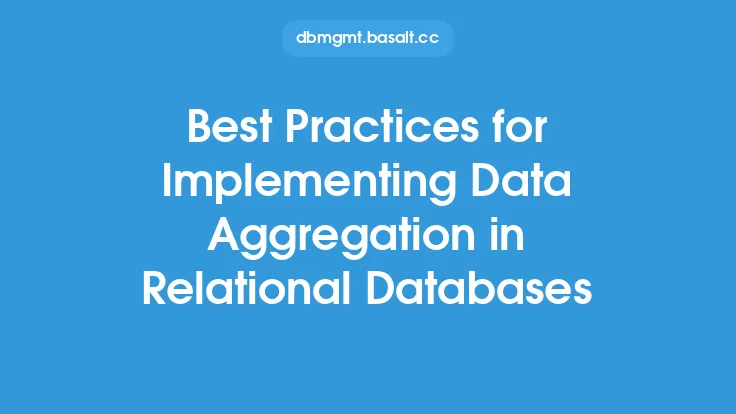Implementing data duplication in database systems requires careful consideration and planning to ensure that it is done effectively and efficiently. Data duplication, also known as data denormalization, involves storing redundant data in a database to improve performance, reduce complexity, or support specific use cases. When implemented correctly, data duplication can significantly enhance the overall performance and scalability of a database system. However, it can also lead to data inconsistencies, increased storage requirements, and additional maintenance complexity if not managed properly.
Introduction to Data Duplication Techniques
There are several techniques for implementing data duplication in database systems, including data caching, materialized views, and data replication. Data caching involves storing frequently accessed data in a cache layer to reduce the number of database queries. Materialized views, on the other hand, involve storing pre-computed results of complex queries to improve query performance. Data replication involves duplicating data across multiple servers or databases to improve availability and performance. Each technique has its own strengths and weaknesses, and the choice of technique depends on the specific use case and requirements.
Designing a Data Duplication Strategy
To implement data duplication effectively, it is essential to design a comprehensive strategy that takes into account the specific requirements and constraints of the database system. This involves identifying the data that needs to be duplicated, determining the frequency of updates, and selecting the most suitable duplication technique. It is also crucial to consider the impact of data duplication on data consistency, integrity, and storage requirements. A well-designed strategy should balance the benefits of data duplication with the potential drawbacks, ensuring that the database system remains scalable, maintainable, and performant.
Implementing Data Duplication in Database Systems
Implementing data duplication in database systems requires careful planning and execution. This involves creating duplicate tables or indexes, setting up data replication or caching mechanisms, and configuring the database system to use the duplicated data. It is essential to ensure that the duplicated data is consistent and up-to-date, which may require implementing data synchronization or update mechanisms. Additionally, the database system should be configured to handle errors and exceptions, such as data inconsistencies or replication failures.
Managing Data Consistency and Integrity
One of the significant challenges of implementing data duplication is ensuring data consistency and integrity. When data is duplicated, there is a risk of data inconsistencies or conflicts, particularly if the duplicated data is updated independently. To mitigate this risk, it is essential to implement data synchronization or update mechanisms that ensure that the duplicated data is consistent and up-to-date. This may involve using transactions, locking mechanisms, or data validation rules to ensure data integrity. Additionally, the database system should be configured to handle errors and exceptions, such as data inconsistencies or replication failures.
Monitoring and Maintaining Data Duplication
Implementing data duplication requires ongoing monitoring and maintenance to ensure that the database system remains performant, scalable, and maintainable. This involves monitoring data consistency and integrity, tracking storage requirements, and adjusting the duplication strategy as needed. It is also essential to ensure that the database system is properly configured and optimized, which may involve tuning database parameters, indexing, or query optimization. Regular backups and disaster recovery mechanisms should also be implemented to ensure business continuity in the event of a failure.
Best Practices for Data Duplication
To ensure that data duplication is implemented effectively, it is essential to follow best practices that take into account the specific requirements and constraints of the database system. These best practices include designing a comprehensive duplication strategy, implementing data synchronization or update mechanisms, ensuring data consistency and integrity, monitoring and maintaining the database system, and regularly reviewing and adjusting the duplication strategy. Additionally, it is crucial to consider the impact of data duplication on storage requirements, data governance, and regulatory compliance. By following these best practices, organizations can ensure that data duplication is implemented in a way that balances performance, scalability, and maintainability with data consistency, integrity, and governance.





